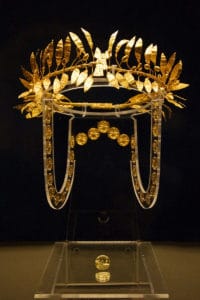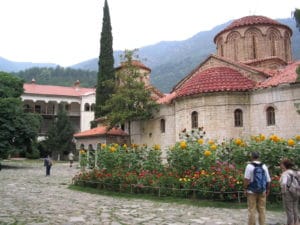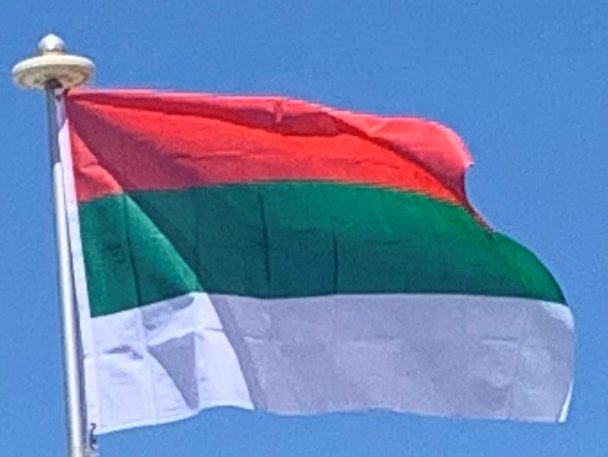
The Thracians, one of the three primary ancestral groups of modern Bulgarians, appeared on the Balkan Peninsula some time before the 12th century BC. The Thracians excelled in metallurgy and gave the Greeks the Orphean and Dionysian cults, but remained tribal and stateless. The Persian Achaemenid Empire conquered most of present-day Bulgaria in the 6th century BC and retained control over the region until 479 BC. The invasion became a catalyst for Thracian unity, and the bulk of their tribes united under king Teres to form the Odrysian kingdom in the 470s BC. It was weakened and vassalized by Philip II of Macedon in 341 BC, attacked by Celts in the 3rd century, and finally became a province of the Roman Empire in AD 45.
By the end of the 1st century AD, Roman governance was established over the entire Balkan Peninsula and Christianity began spreading in the region around the 4th century. The Gothic Bible—the first Germanic language book—was created by Gothic bishop Ulfilas in what is today northern Bulgaria around 381. The region came under Byzantine control after the fall of Rome in 476. The Byzantines were engaged in prolonged warfare against Persia and could not defend their Balkan territories from barbarian incursions. This enabled the Slavs to enter the Balkan Peninsula as marauders, primarily through an area between the Danube River and the Balkan Mountains known as Moesia. Gradually, the interior of the peninsula became a country of the South Slavs, who lived under a democracy. The Slavs assimilated the partially Hellenized, Romanized, and Gothicized Thracians in the rural areas.

First Bulgarian Empire:
Not long after the Slavic incursion, Moesia was once again invaded, this time by the Bulgars under Khan Asparukh. Their horde was a remnant of Old Great Bulgaria, an extinct tribal confederacy situated north of the Black Sea in what is now Ukraine. Asparukh attacked Byzantine territories in Moesia and conquered the Slavic tribes there in 680. A peace treaty with the Byzantine Empire was signed in 681, marking the foundation of the First Bulgarian Empire. The minority Bulgars formed a close-knit ruling caste.
Succeeding rulers strengthened the Bulgarian state throughout the 8th and 9th centuries. Krum introduced a written code of law and checked a major Byzantine incursion at the Battle of Pliska, in which Byzantine emperor Nicephorus I was killed. Boris I abolished paganism in favor of Eastern Orthodox Christianity in 864. The conversion was followed by a Byzantine recognition of the Bulgarian church and the adoption of the Cyrillic alphabet, developed in the capital, Preslav. The common language, religion and script strengthened central authority and gradually fused the Slavs and Bulgars into a unified people speaking a single Slavic language. A golden age began during the 34-year rule of Simeon the Great, who oversaw the largest territorial expansion of the state.

After Simeon’s death, Bulgaria was weakened by wars with Magyars and Pechenegs and the spread of the Bogomil heresy. Preslav was seized by the Byzantine army in 971 after consecutive Rus‘ and Byzantine invasions. The empire briefly recovered from the attacks under Samuil, but this ended when Byzantine emperor Basil II defeated the Bulgarian army at Klyuch in 1014. Samuil died shortly after the battle, and by 1018 the Byzantines had conquered the First Bulgarian Empire.
Byzantine Rule:
After the conquest of Bulgaria, Basil II prevented revolts by retaining the rule of local nobility and relieving their lands of the obligation to pay taxes in gold, allowing tax in kind instead. The Bulgarian Patriarchate was reduced to an archbishopric, but retained its autocephalous status and its dioceses. After the final subjugation of Bulgarian territories by Byzantium, its military and administrative model was imposed in the country. The lands south of the Balkan Mountains were included in the Byzantine provinces (themes) The western parts were separated as the theme Bulgaria, with Skopje as capital. The territory between the Danube and the Balkan Mountains was the theme of Paristrion (lands below Danube), with capital Silistra.
